Fresh bright fish were seen running both the Severn and Teme in mid January, whether or not they were early springers, or late running winter spawners, is an open question. Despite these encouraging signs, high and cold water meant that the season got off to a slow start. It wasn’t till levels had dropped and warmed that the first salmon of the year was reported from the lower river. On February 17th a pristine fish of 20lb fell to the 3 inch black and yellow Devon Minnow fished by Harry Dawson, followed two days later by the second of the season, again to Harry, this time an 18lber from Diglis.
Ross Fullerton accounted for the first Teme salmon on February 22nd with a very fresh fish in the 15lb class on a bright orange Devon with the river 2ft up and clearing.
Ross Fullerton's Teme fish
As water levels continued to fall catches dried up, it was not till another small rise and the spring tides started to build that sport resumed at Diglis in mid March. Successful anglers included: Paul Harris 16lb, Sam Salisbury 17lb, Kelvin Jeavons 16lb, Mark Saunders 10lb. All these fish fell for the charms of a Devon minnow, while elsewhere on the lower river Ian Bott landed a 14lb bar of Severn silver on a Flying C. Two visiting day ticket anglers did well at Diglis on the 23rd catching fish of 10lb on a Rapala and 16lb on the Devon . The most unfortunate angler of the month was Diglis rod Bob Watton had to endure the loss of not just one, but two fish in the twenty pound class on the same day.
One or two other fish were caught including some from the Teme above Tenbury. Catches in February and March were down on the five year average.
A Severn springer comes to the net
April saw an improvement in salmon catches bringing the total to over 40 salmon for the first three months of the season. This is in line with the February to April average since 1999 of 39.
Fish were reported from Tewkesbury all the way up to Melverley. Diglis was the most productive fishery, with catches improving after the spring tides. At least 8 fish were caught from Shrewsbury or upstream and a few from the Teme.
Successful anglers in April included Mark Saunders who had three fish at 19, 14 and 13lb as did Graham Drake with a 15 and two at 18lb. Other Diglis rods in action include Barry Newport with fish of 12 and 13lb, Craig Guy 9 and 16lb, Brian Phillips 18lb, Brian Knight 18lb and Peter Stokes 12lb. All these fish fell for either wooden Devon Minnows or the Flying C.
Ian Bott had the first fly caught fish from the Severn on April 8th, his first ever on the double hander from the river. The sparkling 18lb plus fish fell for a shrimp fly fished on a sink tip. The fish was caught on low and fairly clear water. Ian, who has over twenty years experience spinning and bait fishing for Severn salmon, suggested that in such conditions perhaps the fly could have an edge over the spinner as it is both less obvious, and less likely to spook fish, particularly in shallow glassy water.
Ian Bott's fly caught Severn beauty
Despite the water being on the low side the fish were running through when given even a slight opportunity from the smallest freshet. This reflected water temperatures at 12c/54f or more, levels well above those at which the weirs act as temperature barrier to upstream movement. Big spring fish can run hard, and by mid month there were reliable reports of a few fish as far upstream as the Welsh borders, some 125 river miles from the estuary. Catches would no doubt have been significantly higher if anglers were able to employ the traditional low water worming tactics.
What was particularly encouraging was the good average size of fish in spring at around 15lb. Few really big fish were reported, but that doesn’t mean they weren’t around, as some twenty pound plus fish have stayed under the radar and a few others have been lost.
For much of May the fishing was disappointing. A few fish were picked up early on from the semi tidal sections of the river around Tewkesbury and from odd spots upstream, but as the month went on anglers started to worry about the absence of the main run of May/June two sea winter fish. Rods successful during this period of difficult conditions included Toby Fletcher with fish of 12and 7lb and Harry Dawson with a 10ber, all falling to the flying C.
A rise in water levels later in the month combined with some big spring tides brought the first substantial run of fish into the river for some time. During this brief flurry of activity anglers fishing with the right tactics in the right place managed to contact fish that were running hard. Jeff Mason fishing in the Bridgnorth area landed a salmon of 7lb and a Sea Trout of 2 1/2lbs on a small Toby on Sunday May 24th, while a 15lber was reported from Shrewsbury weir. The next morning Craig Guy managed two of 13 and 6lb on the Devon at Diglis in a short burst of early morning activity, while just upriver Fred Brookes landed his first Severn salmon, a lovely tide bright fish in the ten pound class, which took a Flying C. Despite reasonable numbers of fish being seen at some of the weirs, the fish were not easy to catch and taking very tentatively. This resulted in a certain level of frustration for those anglers able to manage a hook up. Fred Brookes and Ross Fullerton hooked five fish between them over the Sunday and Monday but only one stuck.
The water took some time to fine down and when it did there were a few fish about in some of the main holding pools, but not in anything like the numbers that could be expected for late May. Then as the heat wave hit water temperatures reached 20c at midnight and the odds on tempting a salmon lengthened considerably. As the month drew to a close the odd fish had been picked up from some of the more reliable low water casts especially further upriver, but sport was far below what most Severn anglers would consider normal for May.
June started with low water and fish holding in the estuary waiting to run. Thankfully they didn’t have long to wait and a small rise that coincided with the spring tides from the 3rd of the month brought a good run of salmon into the lower river.
Regular small pulses of water kept fish coming through with good catches made by those anglers who managed to contact a pod of fish as they travelled upstream.
Successful anglers included Ian Bott with a brace of 8 and 11lb on the flying C and Mark Saunders with fish of 10 and 11lb also on the spinner. On the 14th Russ Balmer landed his first ever Severn salmon. It fell for a black Flying C and came after just a few outings on the river.
It was particularly nice to report success for Bob Watton who had to endure losing two good spring fish in the twenty pound bracket on the same day earlier in the year. Bob banked five fish after June 16th including three in a day on July 3rd. Bob’s fish weighed 8lb, 9lb 3oz, 8lb 9oz, 11lb and 10lb 9oz and took either yellow and black Flying C’s or the worm.
I only heard of one fly caught fish from the middle reaches in June, a fine fresh fish of 14lb, though no doubt other anglers were successful. High water temperatures in June, with the river regularly over 20c at midnight and reaching a worrying 23c in the middle of the heat wave, favoured bait. I managed a couple of fish at 11lb and 13lb 8oz from Birmingham Angler’s Association water below Brignorth on the worm and lost another around 12lb when it swam through a hole in the bottom of my net. This episode was an unwelcome reminder of the importance of checking your kit, especially when it is a spare net pressed into service after a season or two in the shed at the mercy of the mice!
Further upriver there were reports of a few fish above and below Shrewsbury on the worm with one angler catching and releasing four up to 12lb from the Montford Bridge area.
Though Severn salmon catches were far from spectacular in 2009, they did seem to be holding up reasonably well. Especially in comparison to the generally down beat reports from other rivers.
This relative stability reflects the fact that salmon fishing on the Severn tends to be heavily concentrated on a few known hotspots around significant barriers to upstream migration. This makes for relatively consistent catches year on year, as it is always possible to contact fish at the bottlenecks. Another factor at play is the fact that the river levels are regulated and some fish enter the system even on low water. These two factors along with the exceedingly light angling pressure (one angler fishing for a few hours for every 20 miles of the Severn, Teme and Vyrnwy) cushions the rod catch from the more volatile fluctuations that other more heavily fished rivers face.
A small rise in levels following heavy thunderstorms in early July coincided with spring tides and falling water temperatures and brought a welcome run of bright summer salmon into the river.
A number of lower river anglers where successful including Craig Guy with a fish of 10lb on the worm on the 6th. The fish quickly pressed on to the middle river. On the 8th July Mark Davies took a brace of 12 and 13lb from a notoriously tricky spot below Bridgnorth in a fine display of long distance precision worming.
A fine brace for Mark Davies
Two days later, Mike Ford landed a 15lb bar of silver below Shrewsbury on the fly. The fish, which fell for a small orange shrimp on a floating shooting head, was Mike’s first ever fly caught Severn salmon in over 50 years of fishing the river. Mike – who is no stranger to catching salmon on the fly from other rivers –told me that having recently taken to using the double hander on the Severn, he had said he would hang up his rods when he finally caught a Severn fish on the fly. But having tasted success he’s already planning the downfall of the next one.
Mike’s fish holds an important lesson for those thinking of taking up the fly on the river. When he first arrived the river looked too coloured for the fly, but when he got in he realised that the sandy coloured sheen was deceptive and he could see about three feet into the water. This is what has been called the ‘privates test’. If you wade to that depth and can still see your feet you’re definitely in business for the fly. Don’t stick to the ‘privates test’ too rigidly though. On the same day and lower down the river Mark Davies contacted a fish of the same stamp in water with no more than two feet visibility by fishing deep with a biggish fly.
Another angler who was successful on the fly was John Bayley who took a fresh 8lber on a small cascade variant fishing a good run below Bridgnorth on the 13th. John’s fish was followed by the first grilse of the year to be landed from the middle river, a tide bright 4lb plus fish taken on the worm by myself.
A fish on the fly for John Bayley
The strangest salmon related story of the month involved Michael Rainbow who was barbel fishing on the 8th July. Ledgering a lump of luncheon meat the size of your thumb Phil found himself connected to an aggressive and tide bright double figure salmon which succeeded in gaining its liberty by shattering the top of his rod. Phil was not rolling his bait, but had it firmly held in place tight to the far bank willows. The fish had obviously opted to investigate a scent trail. This salmon rivals one I saw hooked a few years ago on a couple of onion gravy flavoured meatballs. Along with the small number that each year fall for pellets fished by barbel anglers these fish are proof that we know less about the reasons a salmon takes a lure or bait than we think.
As the month progressed water levels rose as the July monsoon season got under way. Fish were reported from most of the weirs up to Shrewsbury with a number of fish making it through to the upper river as far as upstream of Newtown, where Robert Davies had a fish of 11lb and a fresh run 9lber on worm. Robert’s father also lost a good fresh fish at the start of August providing proof that the summer salmon will run very hard given the right water.
The Teme also produced a number of fish in July mainly to bait. I know of Salmon from the confluence right up to Ludlow. One Teme rod who knows his river well reported three fish in just five short visits.
July was a good month for some. The first of the grilse started to arrive along with summer salmon including a number of very good fish of 20lbs or more seen pushing through. However, the inconsistency of catches from across the system suggested that it was not a particularly good run. The lower river has added little more than a half dozen fish to add to the total in July. Shrewsbury weir has produced only a handful of fish all season, despite being relatively heavily fished, and the upper middle river (from Shrewsbury down to Bridgnorth) fished poorly, for instance, one experienced Shropshire angler, who is a master of both bait and fly, and whom I would consider a byword for consistency, was still without a fish by the end of the month.
August is traditionally a difficult month for salmon fishing on the Severn and 2009 was not an exception. Things were not made any easier by the conditions, as apart from a small rise at the start of the month, the river was low and this did not encouraged many fish to enter the system.
There were a few very small pods of fish moving through as a proportion of the grilse, and even some of the summer salmon, will push through off the tide over the weirs and into the middle river even on low flows. But numbers were low and in the circumstances anglers have had to persevere and keep plugging away if they want to be successful.
One angler who did taste some success was John Bailey who managed 3 fish to the fly over the month from below Bridgnorth. His first, a grilse of 6lb or so, took a one inch Drowned Mouse copper tube on the 6th just as the level was settling and the colour going from the middle river. The other two, a 16lb well rested cock fish and another grilse of 6lb, fell for an Usk Grub on the 30th and coincided with a small rise in levels from rain in the welsh borders. All John’s fish came to a floating shooting head and fast sinking tip and were safely returned.
It was particularly nice to report success for Andy Hollis who landed and returned a fresh 6lb grilse on the fly on the 14th, again from below Bridgnorth. Andy, who is an experienced trout angler and countryman, has only taken up the salmon fly rod on the river this year, so it was great to see him into a fish. His first Severn salmon was followed minutes later by what should have been his second, but it shed the hook. Andy was using a small silver stoat on an intermediate line.
Talking with fly anglers on the river one pattern that did emerge in 2009 was that fish were being picked off when there was nothing showing. Of 15 or so hook ups on the fly in summer 2009 reported to me, in only one case did a fish show beforehand. This is in stark contrast to most recent seasons on the Severn, when a build up of fish in the low water pools and runs usually leads to a certain amount of competition over lies and fish giving away their presence. This underlines the need to persevere and keep plugging away.
Bait anglers on the lower river had a hard August with only half a dozen or so fish coming to the net.
Higher up the river anglers in Wales managed the odd fish that pushed through even on quite low flows. Darren King took a particularly clean fish of 7lb from the Newtown area some 150 plus river miles from the estuary on the 14th and other rods reported some reasonable success on the basis of covering plenty of likely looking spots on the off chance.
One big summer fish of 27lb 14oz which fell to the worm was reported from the river, but the captor wished his name and the venue to remain undisclosed, this fish was contacted at the start of the month at a time when there were a few big fish moving through, perhaps headed for the Vyrnwy.
On the Teme Craig Guy had a fresh ten pounder on the worm on the 6th and rods out on the middle river have seen a few fish about but not the numbers present in recent summers.
The most significant news on the Severn in September was the capture of a huge wild brown trout by Ian Harris of Newtown Powys.
Fishing the local Environment Agency controlled free stretch the fish which weighed in at a massive nine and a half pounds was hooked on a rapala on a falling river. Initially Ian thought he had contacted a salmon, but once on the bank it was clear the fish was a big trout.
Ian Harris's big fish
The question was what kind of trout?
Sea trout do run the river, but how many and of what size is another question. On the other hand, 9lbs is very big for a wild Severn brownie, while the fish had none of the tell tale signs of an escaped stockie.
The only way to get a definitive answer was a proper scale analysis. Charles Crundwell of the EA did the analysis and reported that the fish was indeed a brown trout. According to Charles it appears to be 9-10 years old and judging by the increase in growth it turned to a ferox lifestyle at approximately 3 and 4 years of age. The fish would appear to be a wild fish judging by the scale rings rather than a pampered fish farm fish.
Chris Bainger also from the EA says that the fish is the oldest brown trout he has ever encountered on over 18 years of surveys on the upper Severn.
On the salmon front September saw one decent rise of water and two sets of good tides, but the fish didn’t show up in any numbers.
The lower reaches of both the Severn and Teme produced a few fish to bait mid month, but catches soon fell off to a trickle. Further up the system catches were very low, so those anglers that did taste some success, such as Darren King who had fish of 7lb and 8lb from above Shrewsbury, on the worm and rapala, could take particular pleasure from their achievement. Darren’s 7lber was a remarkably fresh looking fish and perhaps sheds some light on the issue of catches dipping at Shrewsbury weir. It could just be that the new fish pass is making it easier for the fish to run through.
Fly sport saw some improvement on the middle river towards the end of the month, as pulses of compensation water put a little flow and sparkle into river and provided the opportunity for some action. The highlight for me was a frantic battle with a 14lb fish on a single hander after dark.
The last few days of the salmon season in October saw a few fish caught, but no significant back end run of fresh fish. Successful rods included John Bailey with yet another fly caught fish from below Bridgnorth, this time a well rested 15lber that fell for an Usk Grub. Meanwhile on the Teme Andy Selly returned another fish in the 15lb class on worm.
Friday, 24 February 2012
2009 season retrospect
Subscribe to:
Post Comments (Atom)
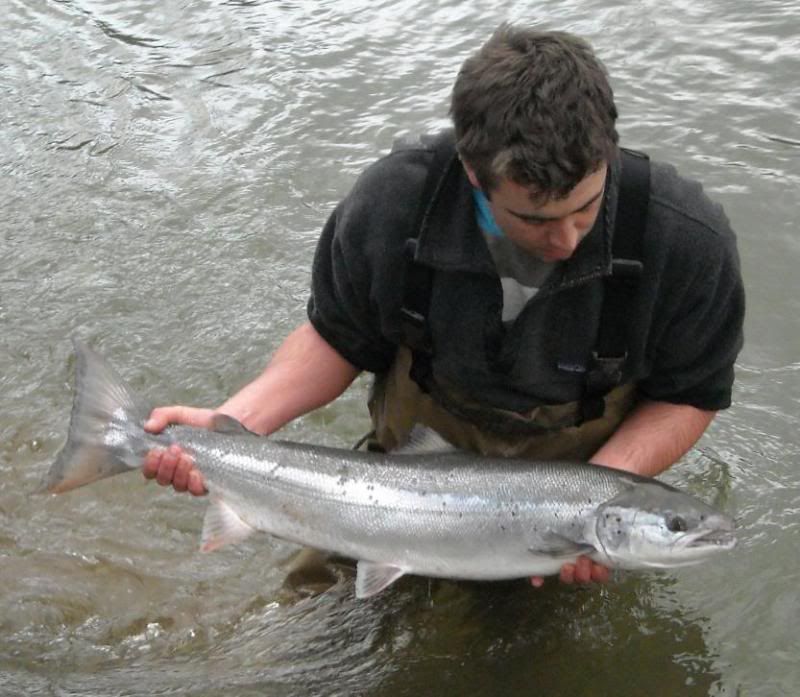
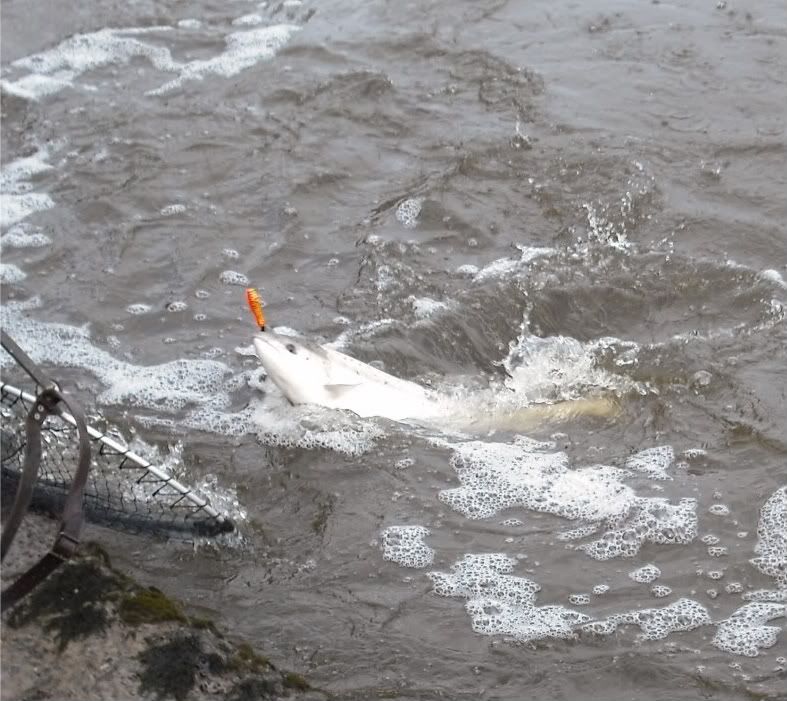
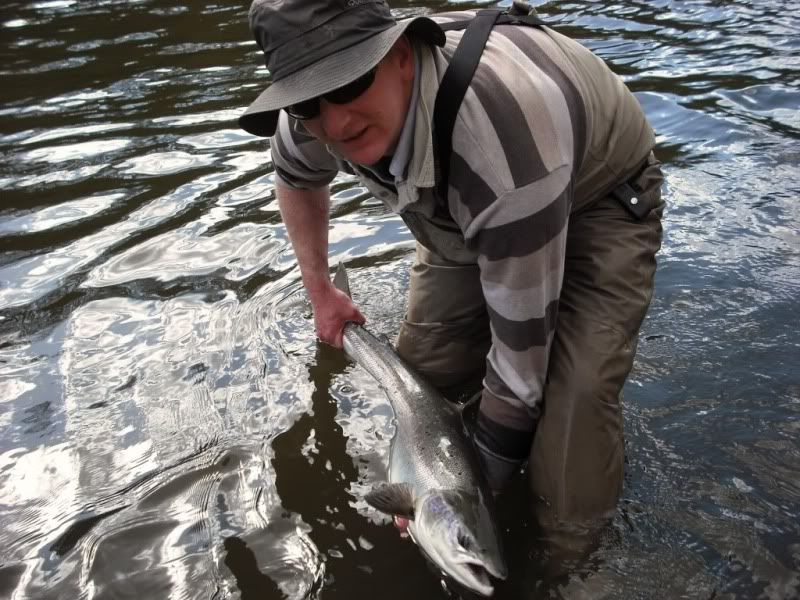
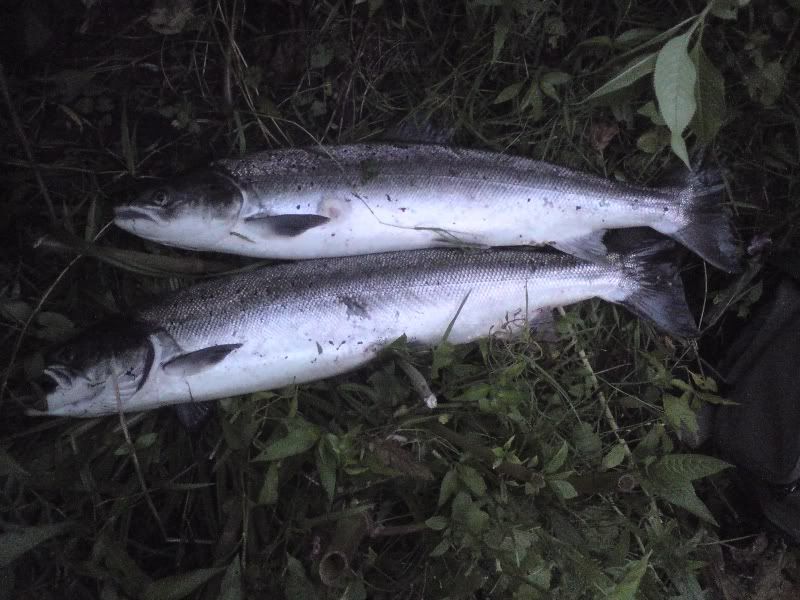
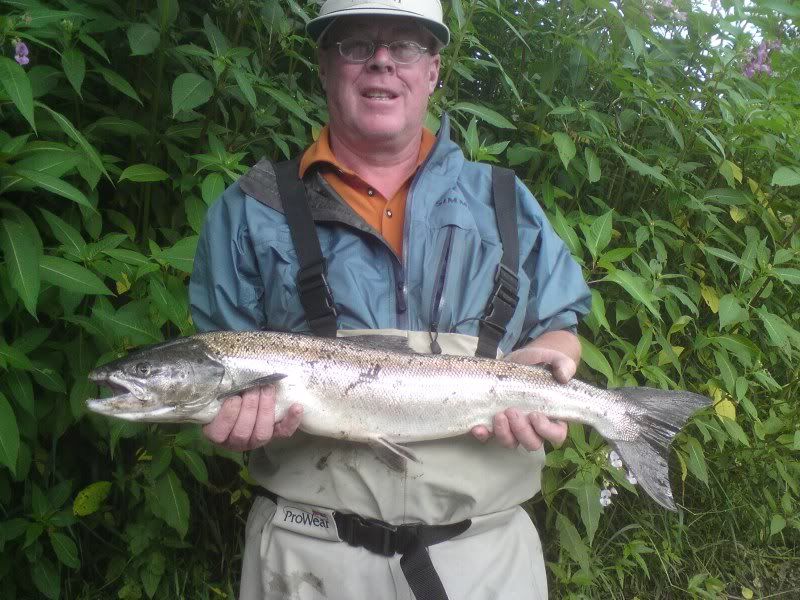
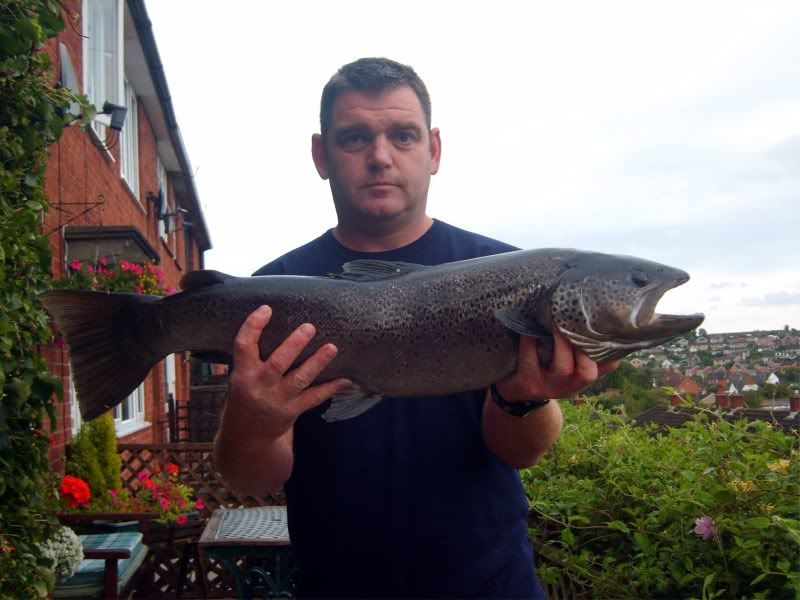
No comments:
Post a Comment
Note: only a member of this blog may post a comment.